Cisco Linksys NWP11B 11 Mbps WLAN Cardbus Card User Manual wpc11 ver3 0 user guide
Cisco-Linksys, LLC 11 Mbps WLAN Cardbus Card wpc11 ver3 0 user guide
Contents
- 1. DoC Statement
- 2. Users Manual Part 1
- 3. Users Manual Part 2
Users Manual Part 1
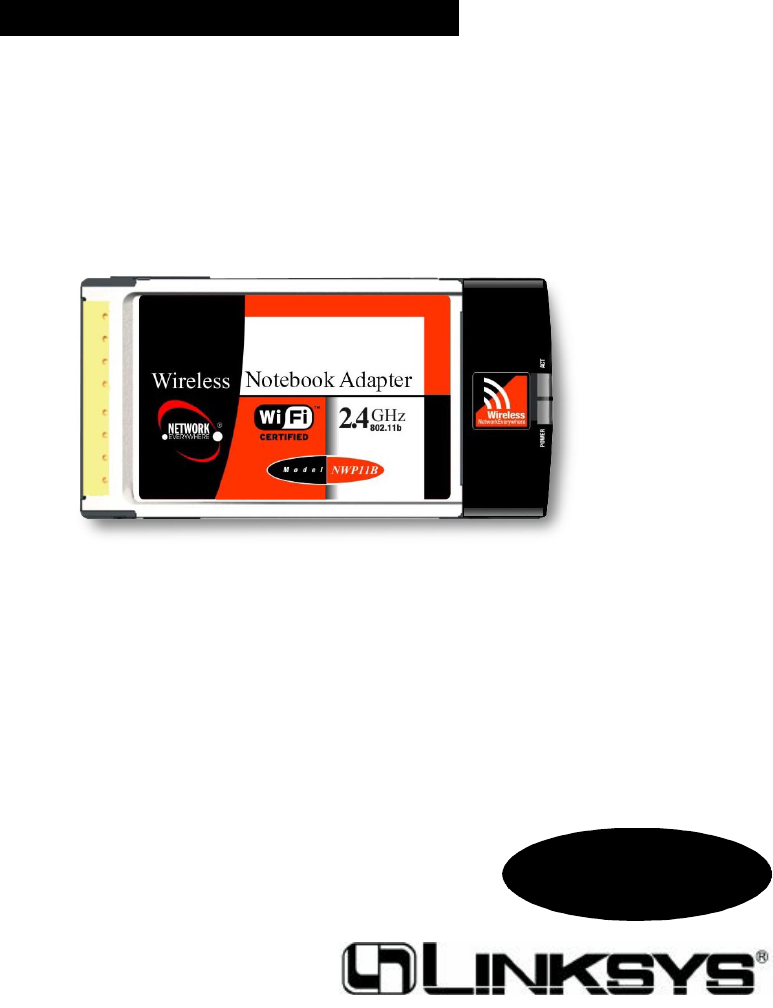
I n s t a n t W i r e le s s T M S e r i e s
Wireless Notebook Adapter
U s e r G u i d e
Use this Guide to install:
NWP11B

COPYRIGHT & TRADEMARKS
Copyright © 2002 Linksys, All Rights Reserved. Instant Wireless™ is a registered trade-
mark of Linksys. Microsoft, Windows, and the Windows logo are registered trademarks
of Microsoft Corporation. All other trademarks and brand names are the property of their
respective proprietors.
LIMITED WARRANTY
Linksys guarantees that every Instant Wireless™ Network PC Card ver. 3.0 is free from
physical defects in material and workmanship for one year from the date of purchase,
when used within the limits set forth in the Specifications chapter of this User Guide. If
these products prove defective during this warranty period, call Linksys Technical
Support in order to obtain a Return Authorization Number. BE SURE TO HAVE YOUR
PROOF OF PURCHASE AND A BARCODE FROM THE PRODUCT’S PACKAGING ON
HAND WHEN CALLING. RETURN REQUESTS CANNOT BE PROCESSED WITHOUT
PROOF OF PURCHASE. When returning a product, mark the Return Authorization
Number clearly on the outside of the package and include your original proof of pur-
chase. All customers located outside of the United States of America and Canada shall
be held responsible for shipping and handling charges.
IN NO EVENT SHALL LINKSYS’ LIABILITY EXCEED THE PRICE PAID FOR THE PROD-
UCT FROM DIRECT, INDIRECT, SPECIAL, INCIDENTAL, OR CONSEQUENTIAL DAM-
AGES RESULTING FROM THE USE OF THE PRODUCT, ITS ACCOMPANYING SOFT-
WARE, OR ITS DOCUMENTATION. LINKSYS DOES NOT OFFER REFUNDS FOR ANY
PRODUCT. Linksys makes no warranty or representation, expressed, implied, or statuto-
ry, with respect to its products or the contents or use of this documentation and all
accompanying software, and specifically disclaims its quality, performance, mer-
chantability, or fitness for any particular purpose. Linksys reserves the right to revise or
update its products, software, or documentation without obligation to notify any individ-
ual or entity. Please direct all inquiries to:
Linksys P.O. Box 18558, Irvine, CA 92623.
FCC STATEMENT
This product has been tested and complies with the specifications for a Class B digital
device, pursuant to Part 15 of the FCC Rules. These limits are designed to provide rea-
sonable protection against harmful interference in a residential installation. This equip-
ment generates, uses, and can radiate radio frequency energy and, if not installed and
used according to the instructions, may cause harmful interference to radio communi-
cations. However, there is no guarantee that interference will not occur in a particular
installation. If this equipment does cause harmful interference to radio or television
reception, which is found by turning the equipment off and on, the user is encouraged to
try to correct the interference by one or more of the following measures:
• Reorient or relocate the receiving antenna
• Increase the separation between the equipment or devices
• Connect the equipment to an outlet other than the receiver’s
• Consult a dealer or an experienced radio/TV technician for assistance
UG-011702B KL
Any changes or modifications not expressly approved by the party responsible for
compliance could void the user's authority to operate this equipment
This transmitter must not be co-located or operating in conjunction with any other
antenna or transmitter

Table of Contents
C hapter 1: I ntr oduction 1
The I nstant WirelessT M 1
Features 1
Package Contents 2
System R equirements 2
C hapter 2: Planning Y our W ireless Networ k 3
Network Topology 3
R oaming 3
C hapter 3: I nstalling the Dr iver s and C onfigur ation Utility for
W indows 95, 98, M E and 2000 4
B efore You Start 4
R unning the A uto Driver Installation 4
Ad-Hoc V ersus Infrastructure Mode 8
Infrastructure Mode 9
Ad-Hoc Mode 11
C hapter 4: I nstalling the Dr iver s and
C onfigur ation Utility for W indows X P 14
C hapter 5: I nstalling the Networ k PC C ar d 16
C hapter 6: I nstalling the Dr iver s and
C onfigur ation Utility for W indows NT 17
Overview 17
Installing the Network PC Card in Y our Notebook PC 17
Installing the Drivers for Windows NT 18
Installing the Configuration Utility for Windows NT 30
C hapter 7: C onfigur ation Utility 30
Using the Configuration Utility 30
C hapter 8: I nstalling Networ k Protocols 39
Network PC Card
Instant Wireless
TM
Series
C hapter 9: A dvanced Pr oper ties 41
Advanced Properties for Windows 95, 98, ME, and 2000 41
Advanced Properties for Windows NT 49
C hapter 10: T r oubleshooting 56
Common Problems and Solutions 56
Frequently A sked Questions 57
C hapter 11: G lossar y 61
C hapter 12: Specifications 68
E nvironmental 68
C hapter 13: War r anty I nformation 69
C hapter 14: C ontact I nformation 70

2
• One Instant W irelessT M Network PC Card ver. 3.0
• One Setup Utility CD-R OM (User Guide on CD)
• Quick Installation insert and R egistration Card (not shown)
• A 16-bit PCMCIA T ype II or T ype III slot
• PCMCIA revisions 2.10 compliant card and socket services
• Windows 95, 98, Millennium, NT, 2000, or X P
• 600 K bytes of free disk space for utility and driver installation
P a c k a ge C ont e nts
S y s t e m R e qu ire m e n ts
Instant Wireless
TM
Series
1
Chapter 1: Introduction
Put the “mobile” back into mobile computing! Whether you’ re at your desk or
in the boardroom, the Instant Wireless™ Network PC Card allows you to share
printers, files, and other resources anywhere within your L A N infrastructure,
increasing your productivity and keeping you “in touch.”
The I nstant Wireless™ Network PC Card now has a new, higher-powered
antenna that provides a greater range than ever. T he increased sensitivity helps
filter out interference and “noise” to keep your signal clear. Improved error
correction in the chipset keeps you operating at higher transmission rates for
longer distances. A nd, since you only need one Type II or III PCMCIA slot,
you’ re free to use your other slots for additional accessories.
R eady to run in T ype II or III PCMCIA -equipped notebook PCs running
Windows 95, 98, Millennium, NT , 2000, and X P, the Instant W ireless™
Network PC Card ver. 3.0 is truly a “must-have” for all notebook PC users.
•11 Mbps High-Speed Data T ransfer R ate
•Compatible with V irtually All Major Network Operating Systems
•Plug-and-Play Operation Provides E asy Setup
•Integrated E qualizer R ecovers W eak Signals and E nhances Sensitivity
•Sturdy Metal Design with Integrated Antenna
•Works with All Standard Internet Applications
•Interoperable with IE EE 802.11b (DSSS) 2.4GHz-Compliant E quipment
•Clear Channel A ssessment Increases Network Throughput
•Hardware B uffer Chaining Provides High Performance While R eading and
Writing B uffers
•Capable of up to 128-B it WEP
•Free T echnical Support—24 Hours a Day, 7 Days a W eek for North A merica
Only
•1-Year L imited Warranty
F e a t ur e s
T he I n s ta n t W ire le s s T M N e tw ork P C C a rd v e r . 3 .0
Network PC Card
Figure 1-1
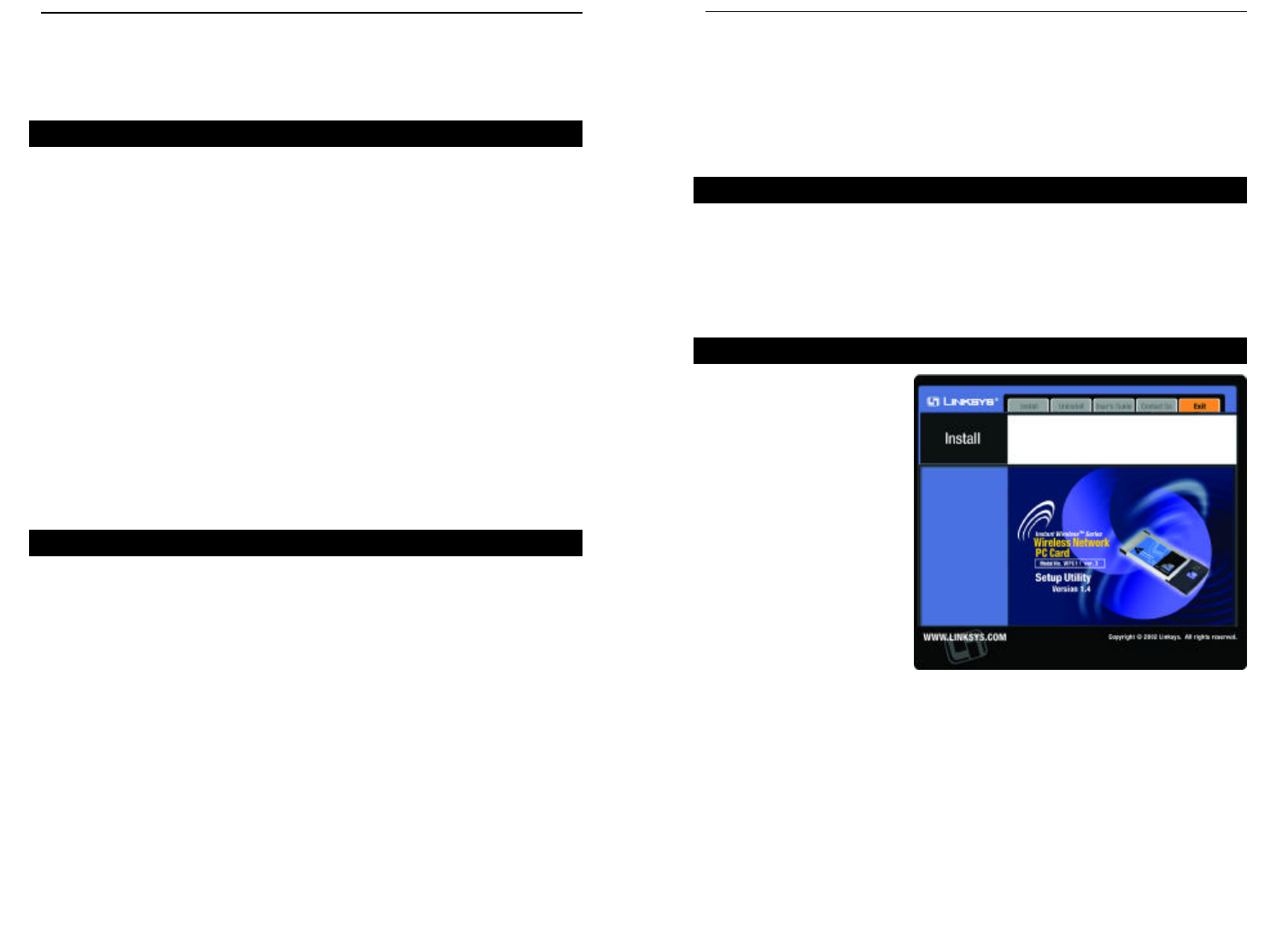
43
Chapter 3: Installing the Drivers
and Configuration Utility for
Windows 95, 98, ME, and 2000
Your new Linksys Instant Wireless™ Network PC Card ver. 3.0 comes with an
automated software installation procedure for Windows 95, 98, Millennium,
and 2000. Windows NT or XP users should refer to the next section. This
new procedure automatically installs the drivers and Configuration Utility
before you insert the Card into your PC, so there’s no searching for the location
of drivers. Again, this step is taken before inserting the Card into your PC.
1. Before installing your
card, insert the Setup
Utility CD into your
CD-ROM drive. Unless
you have deactivated the
auto-run feature of
Windows, the screen
shown in Figure 2-1
should appear automati-
cally.
If this screen does not appear automatically, you can access the installation
by clicking the Start button and choosing Run. In the drop-down box pro-
vided, type D:\setup.exe (where D: is the letter of your CD-ROM drive).
Alternately, double-click My Computer and double-click the CD-ROM
drive where the Setup Utility CD is located. Double-click the Setup.exe icon
in the folder that appears.
Before You Start
Running the Auto Driver Installation
Network PC Card
Chapter 2: Planning Your Wireless
Network
Awireless LAN is exactly like a regular LAN, except that each computer in the
LAN uses an Instant Wireless™ Network PC Card ver. 3.0 to connect to the
network through a wireless connection. Computers in a wireless LAN must be
configured to share the same radio channel.
The Instant Wireless™ Network PC Card ver. 3.0 provides LAN access for
wireless workstations. An integrated wireless and wired LAN is called an
Infrastructure configuration. A group of Instant Wireless™ Network PC Card
ver. 3.0 users and an Access Point compose a Basic Service Set (BSS). Each
PC equipped with an Instant Wireless™ Network PC Card ver. 3.0 in a BSS can
talk to any computer in a wired LAN infrastructure via the Access Point.
An infrastructure configuration extends the accessibility of an Instant
Wireless™ Network PC Card ver. 3.0 PC to a wired LAN, and doubles the
effective wireless transmission range for two PCs equipped with an Instant
Wireless™ Network PC Card ver. 3.0. Since the Access Point is able to for-
ward data within its BSS, the effective transmission range in an infrastructure
LAN is doubled.
Infrastructure mode also supports roaming capabilities for mobile users. More
than one BSS can be configured as an Extended Service Set (ESS). This con-
tinuous network allows users to roam freely within an ESS. All PCs, equipped
with an Instant Wireless™ Network PC Card ver. 3.0, within one ESS must be
configured with the same ESS ID.
Before enabling an ESS with roaming capability, selecting a feasible radio
channel and optimum Access Point position is recommended. Proper Access
Point positioning combined with a clear radio signal will greatly enhance per-
formance.
Roaming
Network Topology
Figure 2-1
Instant Wireless
TM
Series
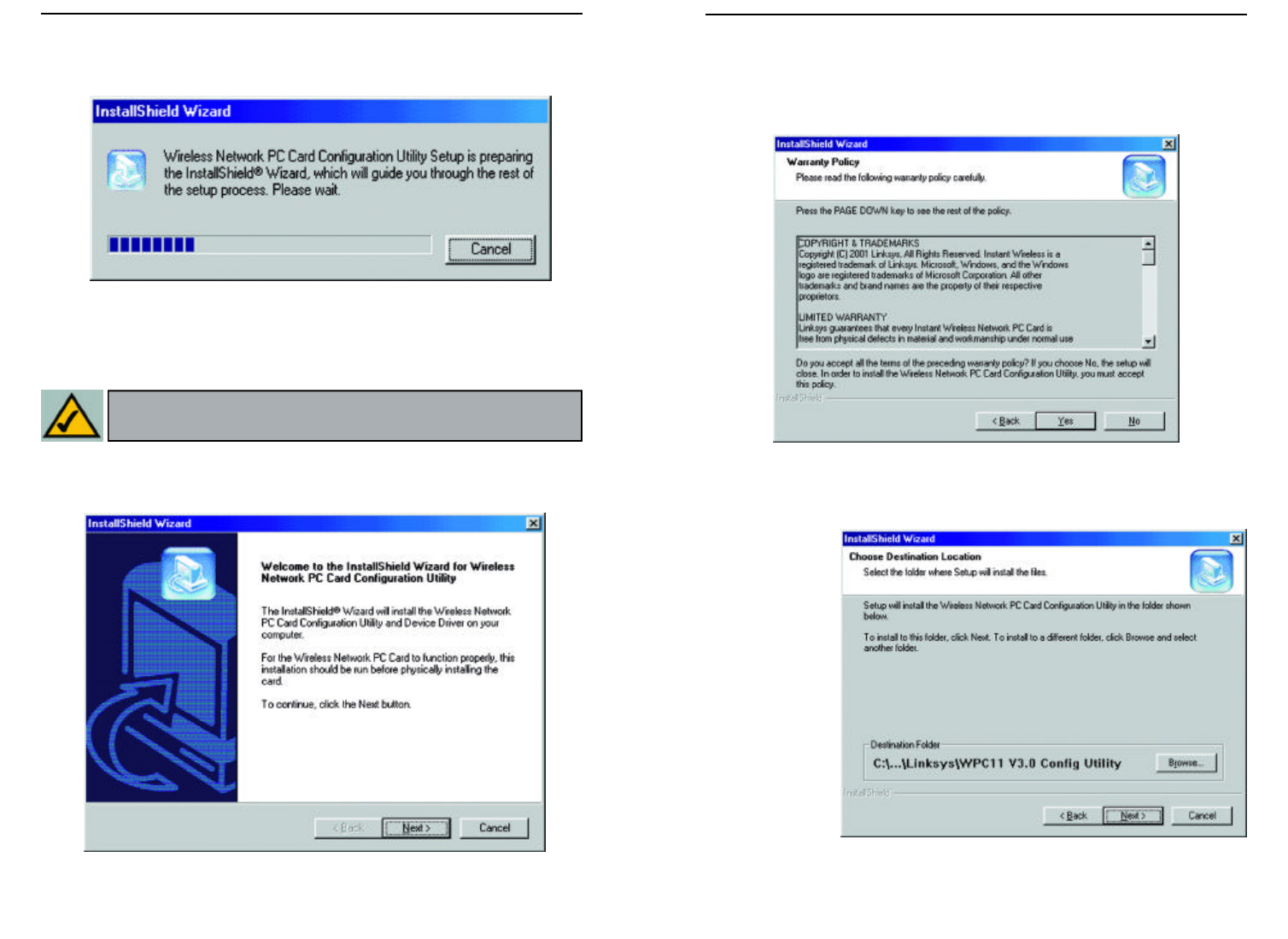
65
4. Figure 2-4 shows the Warranty Policy screen. Read the entire policy by
pressing the Page Down button on your keyboard or by using the on-screen
scroll bar. Click on the Yes button if you agree, or No if you disagree.
Clicking No will terminate the installation. If you click Yes, the installation
will continue.
5. The screen in Figure 2-5 will appear next, requesting the folder into which
the Configuration Utility will be installed. To install the Configuration
Utility in the
default directo-
ry (recom-
mended), click
the Next but-
ton. If you
prefer to install
the Utility in
another direc-
tory, click the
Browse button,
and locate the
preferred
directory.
Then, click the
Next button.
2. The first tab across the top of the screen, labeled Install, should now be high-
lighted. Click the Install button. A screen similar to that shown in Figure
2-2 should appear, indicating that Windows is preparing the installation.
If, for whatever reason, you need to abort or terminate the installation, press
the Cancel button at any time during the installation. Otherwise the instal-
lation will continue automatically.
3. The screen in Figure 2-3 will appear next, indicating that Windows is ready
to continue the installation. Click the Next button.
Note: If you stop the installation before it has finished, you will have to
run the installation completely again before installing your hardware.
Network PC Card
Figure 2-2
Figure 2-3
Figure 2-4
Figure 2-5
Instant Wireless
TM
Series
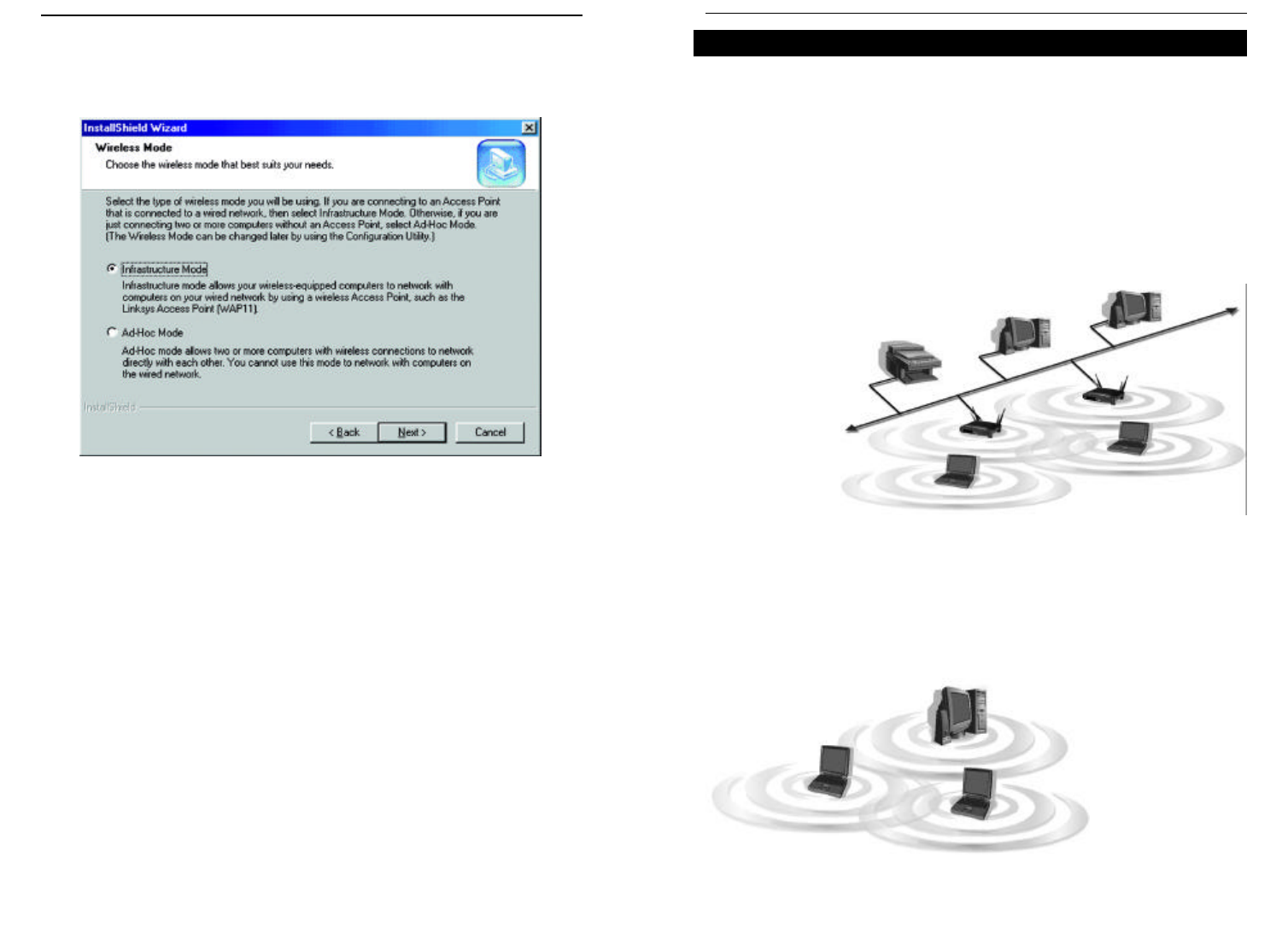
Unlike wired networks, wireless networks have two different modes in which
they may be set up: Infrastructure and Ad-Hoc. Choosing between these two
modes depends on whether or not the wireless network needs to share data or
peripherals with a wired network or not.
If the computers on the wireless network need to be accessible by a wired net-
work or need to share a peripheral, such as a printer, with the wired network
computers, the wireless network should be set up in the Infrastructure mode.
The basis of Infrastructure mode centers around an access point, which serves
as the main point of communications in a wireless network (see Figure 2-7).
Access points transmit data to PCs equipped with wireless network cards,
which can roam
within a certain
radial range of the
access point.
Multiple access
points can be
arranged to work
in succession to
extend the roam-
ing range, and can
be set up to com-
municate with
your Ethernet
hardware as well.
If the wireless network is relatively small and needs to share resources only
with the other computers on the wireless network, then the Ad-Hoc mode can
be used (shown in Figure 2-8). Ad-Hoc mode allows computers equipped with
wireless Network PC Cards to communicate directly with each other, eliminat-
ing the need for an access point. The drawback of this mode is in the fact that,
in Ad-Hoc mode, wireless-equipped computers are not able to communicate
with computers on a
wired network. And,
of course, communi-
cation between the
wireless-equipped
computers is limited
by the distance and
interference directly
between them.
87
Ad-Hoc versus Infrastructure Mode
6. When the screen shown in Figure 2-6 appears, choose either Infrastructure
mode or Ad-Hoc mode. If you are unsure whether to choose Infrastructure
or Ad-Hoc, refer to the next section for more information. Once you have
made your choice, click the Next button.
Network PC Card
Figure 2-6
Figure 2-7
Figure 2-8
Instant Wireless
TM
Series
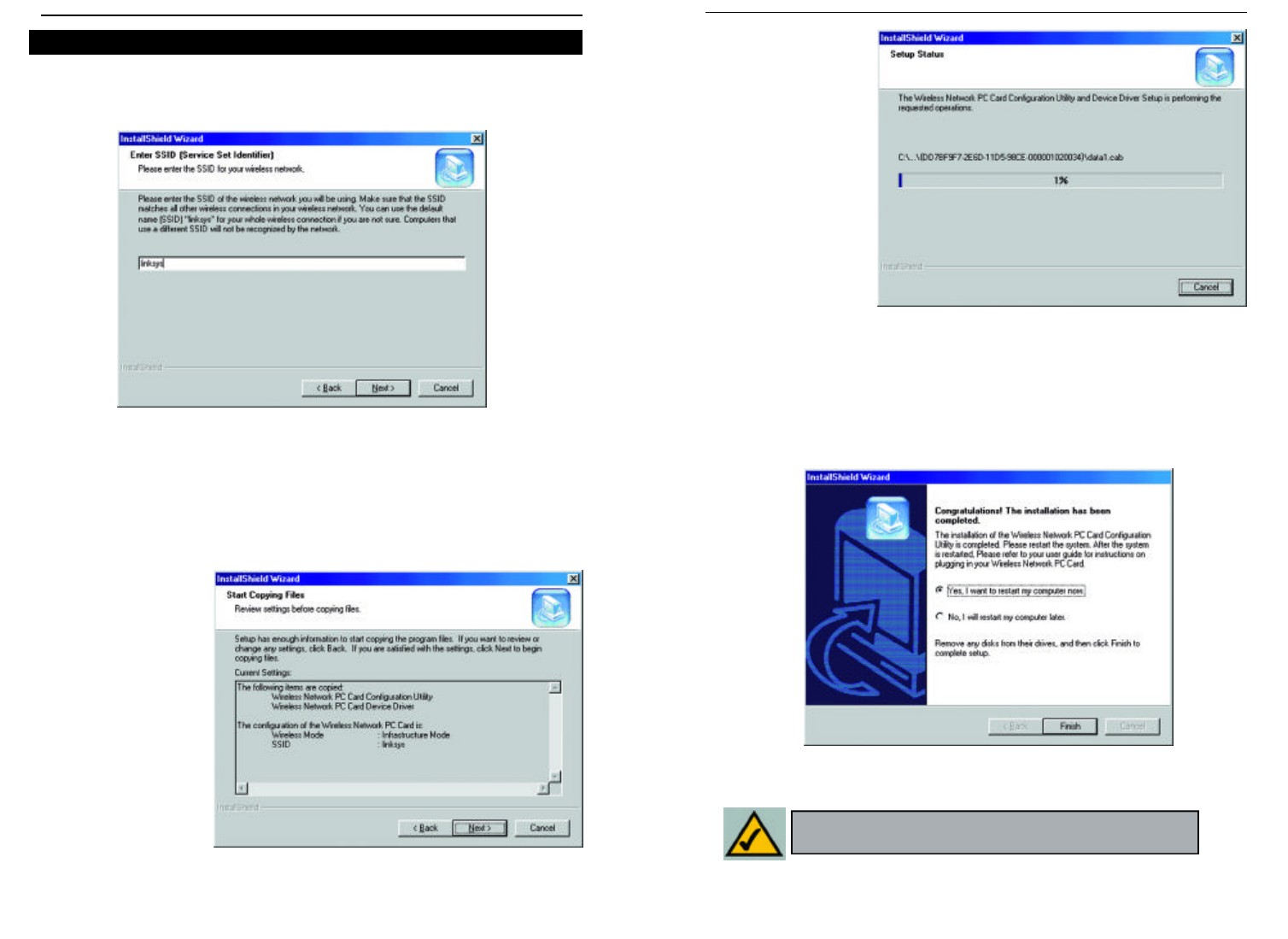
3. The screen shown
in Figure 2-11 will
appear, indicating
that all of the
appropriate files
are being copied
onto your drive.
Click the Cancel
button if you need
to stop the installa-
tion for any reason.
4. Once Windows has finished copying the necessary files, the screen shown
in Figure 2-12 will appear. In order for the drivers to be installed properly,
you must restart your computer. If you choose to do it now, select Yes, I
want to restart my computer now. If you do not want to do it now,
choose No, I will restart my computer later. Once you have made your
choice, click the Finish button to continue.
10
1. If you have chosen Infrastructure mode, the following screen (Figure 2-9)
will appear. If you have chosen Ad-Hoc mode, skip to the next section,
titled “Ad-Hoc Mode”.
You will be prompted to enter an SSID value in the box provided. The
SSID may be up to 32 characters in length. This may include any character
on the keyboard, keeping in mind that the SSID is case sensitive. All SSID
values on your wireless network must match. If you are unsure, use the
default value of “linksys.” Then, click the Next button.
2. The Review
Settings screen
(Figure 2-10) will
appear next. Verify
that all the settings
are correct and
click the Next but-
ton to continue.
9
Note: Restart the computer and go to Chapter 3:
Installing the Network PC Card for further instructions.
Infrastructure Mode
Figure 2-9
Figure 2-10
Figure 2-11
Figure 2-12
Instant Wireless
TM
Series
Network PC Card
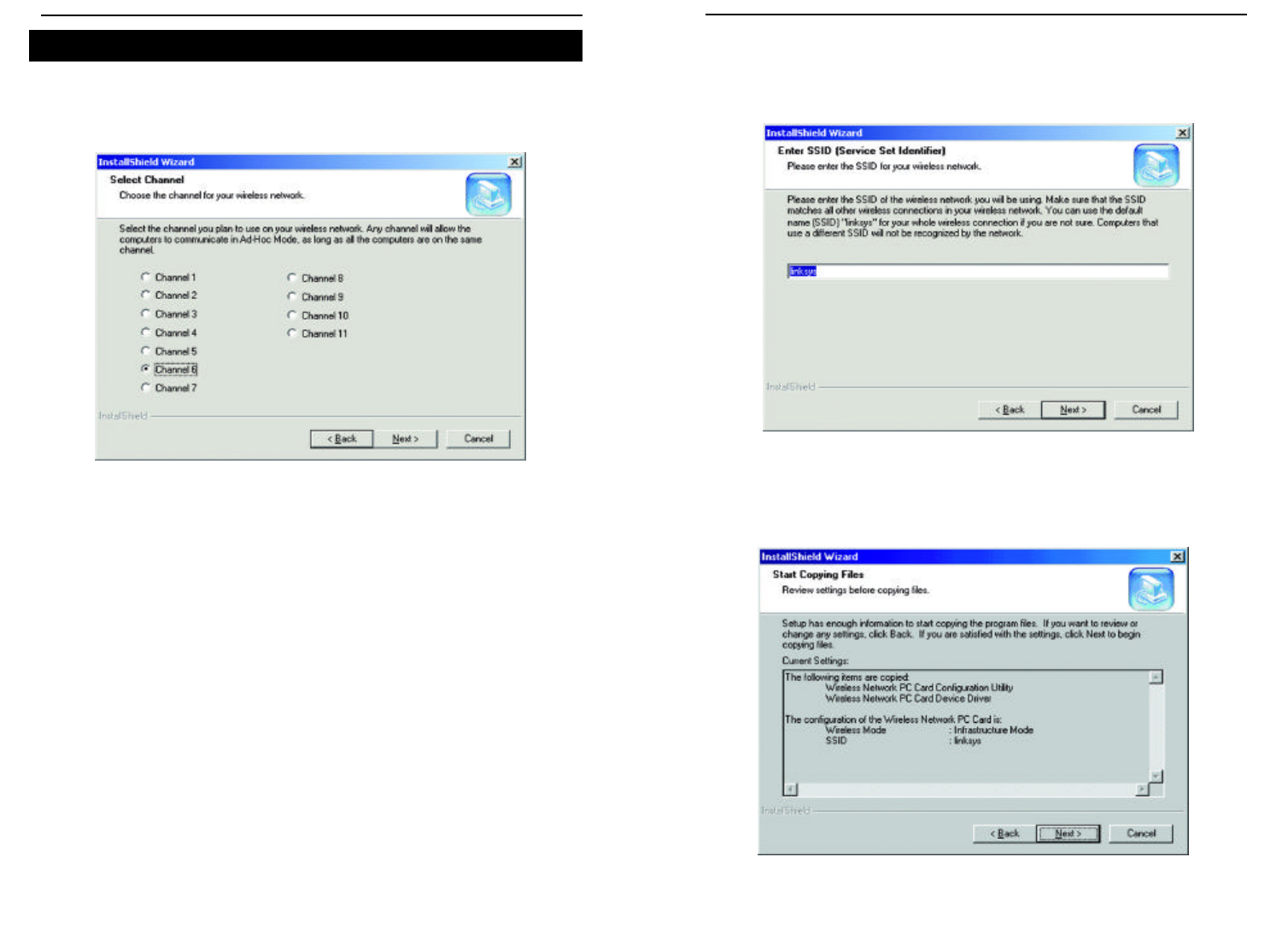
11
2. The screen shown in Figure 2-14 should appear. You will be prompted to
enter an SSID value in the field provided. All SSID values on your wire-
less network must match. If you are unsure, use the default value of
“linksys.” Then, click the Next button.
3. The next screen to appear (Figure 2-15) will be the Review Settings screen.
Verify that all the settings are correct and click the Next button to contin-
ue.
Network PC Card
1. If you have chosen Ad-Hoc mode, the following screen will appear. (See
Figure 2-13.) If you have chosen Infrastructure mode, refer to the previ-
ous section, titled “Infrastructure Mode”.
You will be prompted to choose a Channel from the list provided. All
computers on your wireless network must be using the same channel in
order to communicate with each other. If you are unsure about which chan-
nel to use, select the default channel (Channel 6). Once you have chosen
your channel, click the Next button.
Ad-Hoc Mode
Figure 2-13
Figure 2-14
Figure 2-15
Instant Wireless
TM
Series
12
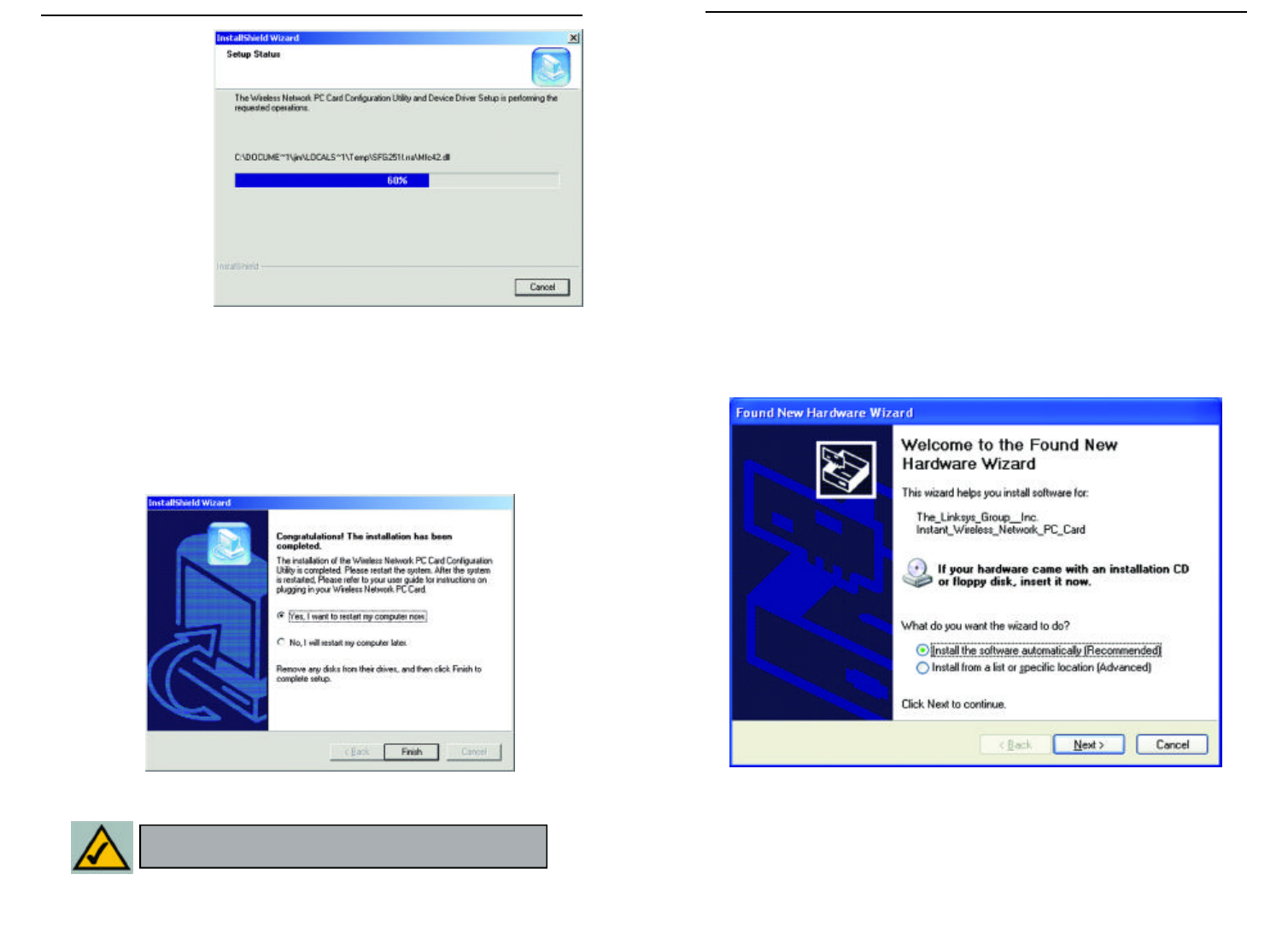
Chapter 4: Installing the Drivers
and Configuration Utility for
Windows XP
Windows XP will automatically walk you through the driver installation
process as well as automatically configure the Network PC Card for your wire-
less network. If you have any questions regarding wireless networking on your
Windows XP PC, please refer to your Windows XP documentation.
To install the Network PC Card’s drivers, insert the Setup Utility CD-ROM into
your CD-Rom drive and then insert the card into your PC’s PCMCIA slot.
Windows XP will automatically detect the card and search for the appropriate
drivers. The screen in Figure 4-1 will then appear.
Verify that the radio button beside Install the software automatically
(Recommended) is highlighted. If not, click it. Then, click the Next button to
continue.
14
4. The next screen
will indicate that all
of the appropriate
files are being
copied onto your
drive. (See Figure
2-16.) Click the
Cancel button if
you need to stop
the installation for
any reason.
5. Once Windows has finished copying the necessary files, a screen similar to
that shown in Figure 2-17 will appear. In order for the drivers to be
installed properly, you must restart your computer. If you choose to do it
now, select Yes, I want to restart my computer now. If you do not want
to do it now, choose No, I will restart my computer later. Once you have
made your choice, click the Finish button to continue.
Network PC Card
Figure 2-16
Figure 2-17
Note: Restart the computer and go to Chapter 5:
Installing the Network PC Card for further instructions.
Figure 4-1
Instant Wireless
TM
Series
13